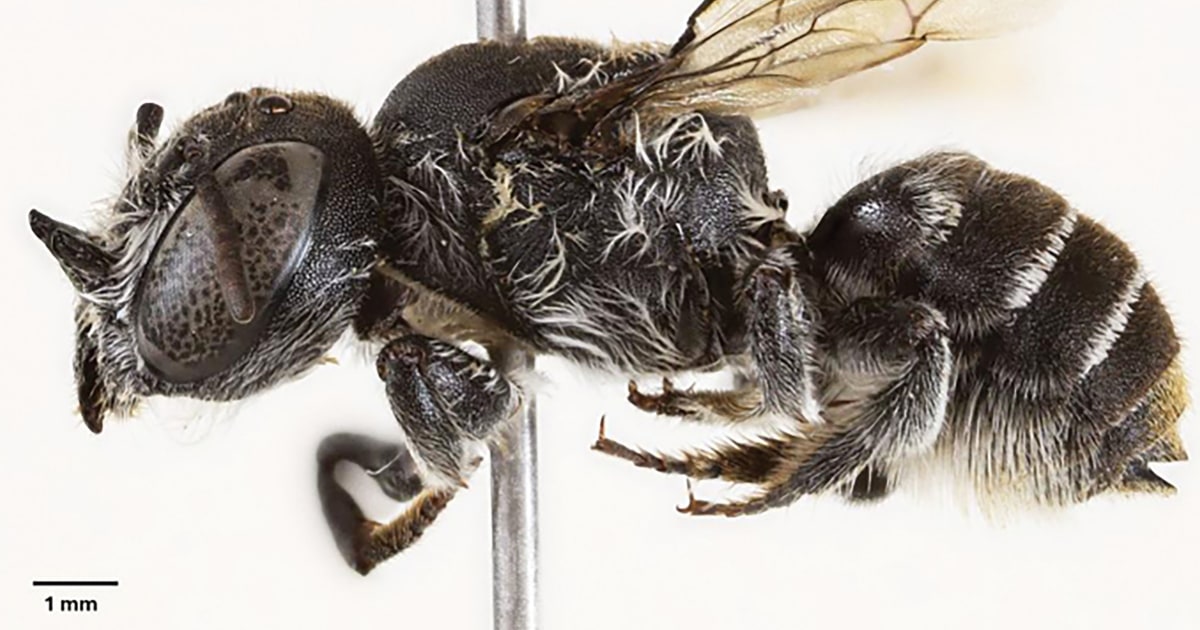Science
Scientists Discover New ‘Lucifer’ Bee Species in Australia

Scientists in Australia have unveiled a new species of native bee, named Megachile lucifer, characterized by its distinctive, horn-like features. This discovery, published on March 25, 2024, in the Journal of Hymenoptera Research, emerged from research conducted in 2019 while surveying a critically endangered wildflower in the Goldfields region of Western Australia.
The bee’s remarkable tiny horns, which measure approximately 0.9 millimeters in length, are believed to play various roles, including accessing flowers and competing for resources. Despite the potential functions of these horns, researchers have noted that their exact purpose remains uncertain. Intriguingly, male bees of this species do not possess these horns.
Lead author of the study, Kit Prendergast, who is also an adjunct research fellow at Curtin University, shared that the inspiration for the name “lucifer” came while she was watching the popular Netflix show of the same name. Prendergast remarked, “When writing up the new species description, I was watching the Netflix show Lucifer. The name just fit perfectly.”
The identification of Megachile lucifer is significant as it marks the first new addition to this group of bees in over 20 years. A subsequent DNA test confirmed that this species does not align with any existing entries in current bee databases, underscoring the importance of ongoing research in this field.
Conservation Concerns and Biodiversity
Prendergast emphasized the pressing need for further studies on native bee populations, as their habitats face mounting threats from climate change and environmental disturbances. “Without knowing which native bees exist and what plants they depend on, we risk losing both before we even realize they’re there,” she stated.
Australia is home to around 2,000 native bee species, yet more than 300 of these have yet to be scientifically described, according to the CSIRO, Australia’s national science agency. Tobias Smith, a bee researcher at the University of Queensland, commented on the lack of data regarding these species. He noted that the conservation status of “almost all species” remains poorly understood, which complicates efforts to protect them.
Smith called for “stronger policies” to safeguard native bees from threats such as habitat loss, improper fire management, and the increased risks posed by megafires. He also encouraged Australians to engage with their local environment, stating, “Get outside and look for some native bees and appreciate them.”
The discovery of the lucifer bee not only adds to the rich diversity of Australia’s native fauna but also highlights the urgent need for conservation efforts. As researchers continue to explore and document these unique species, the findings will be crucial in shaping effective environmental policies and ensuring the survival of Australia’s native bee populations.
-

 Top Stories2 weeks ago
Top Stories2 weeks agoMarc Buoniconti’s Legacy: 40 Years Later, Lives Transformed
-

 Health3 weeks ago
Health3 weeks agoInnovative Surgery Restores Confidence for Breast Cancer Patients
-

 Sports4 weeks ago
Sports4 weeks agoSteve Kerr Supports Jonathan Kuminga After Ejection in Preseason Game
-

 Top Stories2 weeks ago
Top Stories2 weeks agoBOYNEXTDOOR’s Jaehyun Faces Backlash Amid BTS-TWICE Controversy
-

 Science4 weeks ago
Science4 weeks agoChicago’s Viral ‘Rat Hole’ Likely Created by Squirrel, Study Reveals
-

 Lifestyle4 weeks ago
Lifestyle4 weeks agoKelsea Ballerini Launches ‘Burn the Baggage’ Candle with Ranger Station
-

 Entertainment4 weeks ago
Entertainment4 weeks agoZoe Saldana Advocates for James Cameron’s Avatar Documentary
-

 Politics4 weeks ago
Politics4 weeks agoDallin H. Oaks Assumes Leadership of Latter-day Saints Church
-

 Business4 weeks ago
Business4 weeks agoTyler Technologies Set to Reveal Q3 2025 Earnings on October 22
-

 Business3 weeks ago
Business3 weeks agoZacks Research Downgrades Equinox Gold to Strong Sell Rating
-

 Health3 weeks ago
Health3 weeks ago13-Year-Old Hospitalized After Swallowing 100 Magnets
-

 Business2 weeks ago
Business2 weeks agoForeign Inflows into Japan Stocks Surge to ¥1.34 Trillion









